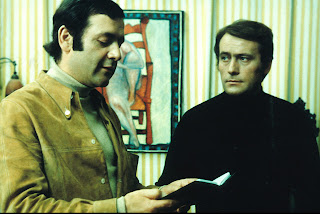Specifically the 1969 Fiat 124 Sport Spider I researched and obsessed over after Saturday night's screening of Que la Bête Meure (1969) at the LACMA in West Hollywood. French New Wave Director Claude Chabrol's thriller set on the French coast of Brittany was a feast for the car-lover as well as the usual moderately pretentious European film-goer. (Aye...no huffs. I'm including myself in that one.) It pays to know that the Mustang is an American car, because it's not coincidence that the 1966 black Mustang is driven by the villain. The car becomes a symbol of reckless violence and arrogance, while the protagonist's Fiat is a symbol of restrained intensity and dutiful elegance. It is most definitely white. White knight, white car.
I need to point out this amazing website I just came across. Take heed: it's baller. IMCDb.org is the Internet Movie Cars Database. The collection from the film:
Now would normally be the time I'd show a picture of myself leaning with charisma against the polished lines of my own car, unfortunately, my 91 Toyota Camry with a couple slashes of duct tape doesn't making the "sharing" cut. But you can imagine as I drove back down Wilshire after an orgy of sports cars driven by attractive men, I dreamt of a future behind the wheel of something just as fly. It looks a little something like this:
 But back to the film...or at least a reflection on the New Wave and their cars. The classic traffic jam scene from Godard's Week End (1967) is an example. Like a dog who looks like their owner (or vice versa) the car is a reflection of the character. Both Week End and Que la Bête Meure have in common the image of the destroyed, abandoned vehicle. Godard even sets a couple on fire. Is it looking too far into the car images to declare them a reflection of the plight and/or nature of the characters?
But back to the film...or at least a reflection on the New Wave and their cars. The classic traffic jam scene from Godard's Week End (1967) is an example. Like a dog who looks like their owner (or vice versa) the car is a reflection of the character. Both Week End and Que la Bête Meure have in common the image of the destroyed, abandoned vehicle. Godard even sets a couple on fire. Is it looking too far into the car images to declare them a reflection of the plight and/or nature of the characters?Que la Bête Meure has an intensity built on one man's search for the driver of a black car that hit and killed his young son. (This man/beast must die.) Apart from my new car obsession, this film contained something quite unique and lovely: a strong female character played expertly by a strong actress. Caroline Cellier, as the weak but still admirable Helene Lanson, endeared me with her soft features and almost nervous frailty, as well as with her charm, wit, and physical ease. Michel Duchaussoy as protagonist Charles Thenier is the French Peter O'Toole, and the gradual shift from the bitter nature of his initial pursuit of her affections to their bittersweet relationship creates some of the best tension in the film.
This film is as much about parting and loneliness as it is about retribution and revenge. Iconic French Cinematographer Jean Rabier drifts his camera in and away from singular figures adrift in the ocean or walking along the rock and tides. Whether angelic or fallen angel, the images remain haunting and melancholic. The comedy of life that Chabrol hints to in wonderful moments of social interaction, is lost when his characters are left to wander alone.
The ocean plays such a part in this film, I can't help but feel that ache for Maine. Too bad I would only be able to drive my dream car for 3 months out of the year. Maybe my next stop after LA will be the French Coast--thank you for the inspiration Chabrol.
And thank you LACMA. Check out a calendar of their screenings: LACMA film









No comments:
Post a Comment